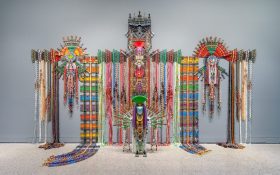The sector responds
Given the sudden nature of the announcement, many artists have been left blindsided and apprehensive. CEO of the National Association of the Visual Arts (NAVA) Esther Anatolitis said, ‘I think news is shocking and has a detrimental impact on artists who are already feeling the pain of cuts and multiple multi-year funding applications. We’re still dealing with the shockwaves of the last years funding cuts. So when you have an unannounced restructure it contributes to that sense of disarray and confusion.’ Anatolitis is convinced that this is a poor signal to send to artists and arts organisations at a time when they are already under pressure. ‘What artists need to hear is that the Australian Government has confidence in them and their work. This is a confusing announcement from a prime minister trying to make some efficiency measures. But we now have a Federal ministry that doesn’t have the arts in it, when every study shows the importance of the arts to the economy and to our future,’ she continued. Many artists and arts workers echoed Anatolitis’ sense of apprehension and shock online:Ministerial portfolios have been unchanged by the restructure – but the changes look set to keep coming. In the press conference announcing the restructure, Morrison stated that there were further changes afoot, with more announcements to be made as early as next week.According to the (former) Department of Communications and the Arts, cultural and creative activity in Australia contributes over $100 billion to the economy annually.
But that’s chickenfeed, right? And honestly, why encourage them. We’ve got an economy to run. — Nick Feik (@NickFeik) December 5, 2019
The new name is the Department of Infrastructure, Transport, Regional Development and Communications. ‘The Arts’ have dropped off completely, which is a sure sign that they’re not a concern for this govt. Expect more funding cuts to orgs etc
— Joshua Badge (@joshuabadge) December 5, 2019
While Morrison insists these changes are intended to increase efficiency, rather than as a money saving measure, they come hot on the heels of several major industry cuts. The latest of these was the shocking $783 million loss in funding the ABC over a four year period. The cuts to the Australia Council for the Arts between 2016 and today have also taken their toll, with as few as 55% of invited applicants expected to receive four year funding, leaving around 70 applicants without this crucial support – not to speak of the 250 who didn’t make it past the Expression of Interest stage.
Until we know more about the fallout of this restructure, artists and arts workers are bracing themselves; the worst may well be yet to come.





